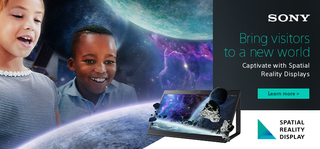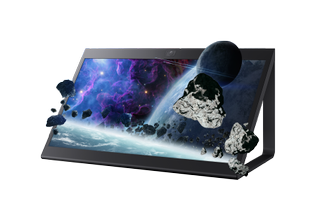Sony Spatial Reality—The Next Seismic Leap in Display Technology
We’ve all felt the effects of technological innovation on our work and personal lives. Often, the influences are subtle. On rare occasions, however, the impact is so dramatic, it completely transforms the technological landscape as we know it. Sony’s recently announced Spatial Reality Display fits into this category. Akin to the seismic shift from black-and-white to color TV, the Spatial Reality Display has taken a quantum leap in the world of 3D, introducing consumers to a whole new way of using 3D for greater productivity, efficiency and enjoyment. To better understand the innovation behind Sony’s game-changing Spatial Reality Display, why it was developed, how this volumetric 3D differs from legacy holographic 3D solutions and its effect on the way we work, live, and play, we spoke with Chris Feldman, Sony Spatial Reality Display business manager.
Q: What makes Sony’s Spatial Reality Display different from other solutions on the market?
A: In the past, consumers needed to don a special headset or glasses to view images in 3D. Now, for the first time, they can visualize and create in a 3D environment by simply looking at the 27-inch screen of the Spatial Reality Display—no additional hardware required! The high-res display resembles a typical computer monitor yet performs like nothing you’ve ever seen before. A complete, turnkey solution, it brings objects to life, allowing a user to see every angle and aspect of a product design, surgical procedure, architectural rendering, and a host of other applications. Plus, the imagery is fluid, moving naturally with your gaze to provide an authentic experience, which mitigates the typical fatigue associated with glasses and headsets.
Q: How does the technology driving the Spatial Reality Display improve on previous 3D solutions?
A: Most other 3D solutions utilize lenticular 3D technology, which provides a narrow field of view. By comparison, the Spatial Reality Display employs volumetric 3D technology combined with Sony’s unique high-speed eye tracking sensor to enable users to see objects on all three axes: vertical, horizontal and depth, much like a hologram. The sensor tracks a user’s eye movement down to the millisecond to accurately reposition the 3D image as if you were looking at it from above or peering around it from the side, for example. This creates the most natural 3D experience available today. Being able to see and work with 3D images from multiple viewing positions and have the image move as your position shifts creates a more comfortable, efficient workflow.
Why was it developed?
“Sony has always been a leader in visual technology and a pioneer of 3D. Our next logical step was to develop a more natural 3D experience with enhanced dimensionality and realism, along with all the clarity, color accuracy, brightness, contrast and texture of our legacy displays. ” – Chris Feldman on the Sony Spatial Reality Display
Q: Why was the Spatial Reality Display developed?
A: Sony has always been a leader in visual technology and a pioneer of 3D. Our next logical step was to develop a more natural 3D experience with enhanced dimensionality and realism, along with all the clarity, color accuracy, brightness, contrast and texture of our legacy displays.
Q: For which markets is it designed?
A: The intuitiveness, ease of use, and accuracy of the Spatial Reality Display makes 3D a viable and useful tool for a wider range of markets than ever before. Professions in creative, medical, technical, and manufacturing fields, including 3D CAD and design, simulation, medical imaging, volumetric imaging, pointcloud visualization, pre-visualization, and robotics can easily implement the Spatial Reality Display into their workflow for more accurate visualization and perspective of product prototypes, medical procedures, and scientific exploration, as well as heightened experiences in learning, social, and entertainment environments. Solutions to problems can be uncovered quickly, features added to products efficiently, and individuals who may be unfamiliar with 3D designs gain greater clarity and understanding of projects as they unfold.
Q: What types of customers are taking advantage of this technology and in which applications?
A: A wide range of customers are already benefiting from Sony’s Spatial Reality Display. For a car manufacturer, the technology is inspiring creativity and closer scrutiny of designs before they become prototypes. This results in reduced costs and shortened lead times for product development. For an architectural firm, the Spatial Reality Display allows designers to communicate 3D concepts to clients, consultants and contractors with greater accuracy. Customers can “walk through” a realistic environment to gain greater perspective of the project, resulting in closer collaboration and quicker approval of the design. Last but not least, the Spatial Reality Display is helping generate new business for a production studio. They are using the technology to create holographic entertainment media for their clients to use on concert tours, business conferences and other events. The Spatial Reality Display is differentiating their company and establishing it as a leader in the business.
For more information about Sony’s Spatial Reality technology and where to purchase a display, please visit the Sony Spatial Reality Display website.
#Sony #Spatial #RealityThe #Seismic #Leap #Display #Technology



